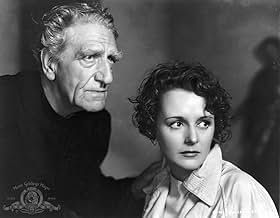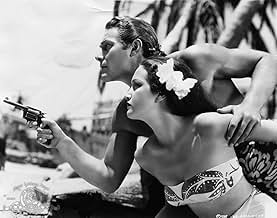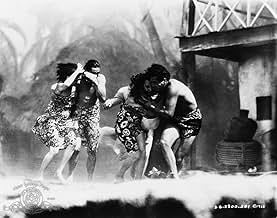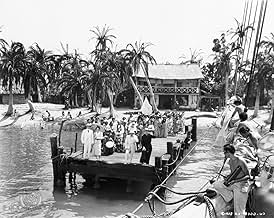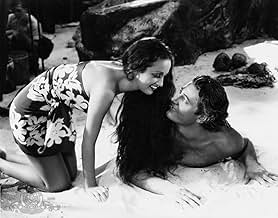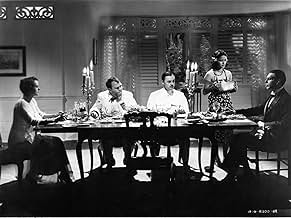IMDb RATING
7.1/10
3.2K
YOUR RATING
A Polynesian sailor unjustly imprisoned after defending himself against a colonial bully is relentlessly persecuted by his island's martinet French governor.A Polynesian sailor unjustly imprisoned after defending himself against a colonial bully is relentlessly persecuted by his island's martinet French governor.A Polynesian sailor unjustly imprisoned after defending himself against a colonial bully is relentlessly persecuted by his island's martinet French governor.
- Won 1 Oscar
- 3 wins & 2 nominations total
Lionel Braham
- The Governor
- (uncredited)
John Casey
- Native
- (uncredited)
Spencer Charters
- Judge
- (uncredited)
Anne Chevalier
- Reri
- (uncredited)
Featured reviews
Some parts are terribly corny with dialog handed to the actors in the form of declamations but overall a well directed and enjoyable film. The picture doesn't require any heavy lifting dramatically but Hall is fine in the lead, certainly a dashing protagonist and Dorothy of course looks great in her sarong. It's the supporting cast, a collection of dynamite character actors, that make this memorable. Any movie lucky enough to have Mary Astor, Thomas Mitchell, Jerome Cowan, Raymond Massey and John Carradine contributing their individual presence is worth seeing if only for them but this has good special effects, for the time, and a fun story to boot.
JON HALL stars as a hot-tempered native on a fictional South Seas island called Manakoora, run by a strict martinet of a governor, played by RAYMOND MASSEY. After petty theft and a brawl, Hall is hauled into jail and given a strict sentence that separates him from his new wife, a native girl Marama played by DOROTHY LAMOUR.
Hall and Lamour are both in their physical prime. Hunky Hall is shown to advantage in the central role in a series of adventurous escapes from prison, climaxed by his authority in leading some of the islanders to safety during the climactic storm. Close-ups magnify Lamour's sultry beauty and handsome Hall is likewise photographed like a Greek God in profile. Ford has directed a film rich in character and settings with some stunning B&W photography.
Aside from the leads, good character roles are abundant. RAYMOND MASSEY, MARY ASTOR (as his loyal wife), THOMAS MITCHELL (another one of his drunken doctor roles) and JOHN CARRADINE as a sadistic warden, are all memorable.
Escapist entertainment with a South Seas setting and two photogenic co-stars who would both move on to better things in the '40s. But Jon Hall never had a better role than he does here as Terangi, the resourceful man who dives off a steep cliff into the calm waters of an enchanted island paradise during one of his many escapes.
As for "the hurricane", it's so realistic that you have to see it to believe it. And all this was before CGI effects--a brilliant job.
Alfred Newman's exotic background music is woven around a theme later called "The Moon of Manakoora" and turned into a popular song for Dorothy Lamour to warble. After seeing her in this film, no wonder she became the sarong girl of the '40s.
Hall and Lamour are both in their physical prime. Hunky Hall is shown to advantage in the central role in a series of adventurous escapes from prison, climaxed by his authority in leading some of the islanders to safety during the climactic storm. Close-ups magnify Lamour's sultry beauty and handsome Hall is likewise photographed like a Greek God in profile. Ford has directed a film rich in character and settings with some stunning B&W photography.
Aside from the leads, good character roles are abundant. RAYMOND MASSEY, MARY ASTOR (as his loyal wife), THOMAS MITCHELL (another one of his drunken doctor roles) and JOHN CARRADINE as a sadistic warden, are all memorable.
Escapist entertainment with a South Seas setting and two photogenic co-stars who would both move on to better things in the '40s. But Jon Hall never had a better role than he does here as Terangi, the resourceful man who dives off a steep cliff into the calm waters of an enchanted island paradise during one of his many escapes.
As for "the hurricane", it's so realistic that you have to see it to believe it. And all this was before CGI effects--a brilliant job.
Alfred Newman's exotic background music is woven around a theme later called "The Moon of Manakoora" and turned into a popular song for Dorothy Lamour to warble. After seeing her in this film, no wonder she became the sarong girl of the '40s.
Sure, the leads are silly, and there's a great deal of mannered melodrama to endure, but don't overlook this. Academy Award nominations for Thomas Mitchell and Alfred Newman, and a well-deserved Oscar win for Thomas Moulton, the credited sound guy. The 10 minute Hurricane sequence plays entirely without music; just sound effects and scattered dialog, shouted over the wind and waves. You'll forget that the wind is ringing the church bell constantly through the storm, until the church is washed away and the bell sound is suddenly gone. The visual action and stunts are extraordinary and ahead of their time. I show this sequence to my film sound students, and I wish I could get it on DVD!
It took John Ford another 18 years to get back to the south seas as a film location after his award winning The Hurricane. He had an incomplete trip with Mister Roberts in 1955, but then made it back for Donovan's Reef in 1963.
Both The Hurricane and Donovan's Reef deal with racism and have as their settings, French colonial possessions in the south Pacific. Of course Donovan's Reef takes a far more light hearted approach. In both films Ford feels that colonialism is at best a mixed blessing for the native populace.
Jon Hall is a happy and content resident of the small island of Manakoora with a new wife. He's a sailor by trade, first mate on a ship captained by Jerome Cowan. While in Tahiti he defends himself in a barroom brawl, but gets sentenced for assault because he struck a white man. An obnoxious lout with political influence. His lot is made worse with repeated attempts to escape adding time on his sentence and all kinds of torture, physical and psychological, by a cruel guard played by John Carradine.
Meanwhile back on Manakoora wife Dorothy Lamour gives birth to a child and Hall becomes something of a native folk hero. That's most unsettling to the Governor Raymond Massey. Massey is one uptight dude with a lot of issues. He says he's defending the law, but he knows he's defending the concept of white supremacy and that fact isn't escaping any of his peers including his own wife Mary Astor.
Thomas Mitchell got nominated for his performance as a doctor with a bit of a thirst problem on Manakoora. A decent man, he's revolted by a lot of what he sees. As is C. Aubrey Smith the priest. Both Mitchell and Smith take comfort where they can, Mitchell in booze, Smith in his Catholic faith. Mitchell lost to Joseph Schildkraut for Best Supporting Actor, but two years later won with essentially the same role in Stagecoach.
The Hurricane won the very first Oscar given out for Special Effects and the hurricane which should have been called a typhoon in that part of the world even today is something to see. You will not forget the fury of nature that destroys C. Aubrey Smith's church. This ain't your Wizard of Oz type storm.
Both The Hurricane and Donovan's Reef deal with racism and have as their settings, French colonial possessions in the south Pacific. Of course Donovan's Reef takes a far more light hearted approach. In both films Ford feels that colonialism is at best a mixed blessing for the native populace.
Jon Hall is a happy and content resident of the small island of Manakoora with a new wife. He's a sailor by trade, first mate on a ship captained by Jerome Cowan. While in Tahiti he defends himself in a barroom brawl, but gets sentenced for assault because he struck a white man. An obnoxious lout with political influence. His lot is made worse with repeated attempts to escape adding time on his sentence and all kinds of torture, physical and psychological, by a cruel guard played by John Carradine.
Meanwhile back on Manakoora wife Dorothy Lamour gives birth to a child and Hall becomes something of a native folk hero. That's most unsettling to the Governor Raymond Massey. Massey is one uptight dude with a lot of issues. He says he's defending the law, but he knows he's defending the concept of white supremacy and that fact isn't escaping any of his peers including his own wife Mary Astor.
Thomas Mitchell got nominated for his performance as a doctor with a bit of a thirst problem on Manakoora. A decent man, he's revolted by a lot of what he sees. As is C. Aubrey Smith the priest. Both Mitchell and Smith take comfort where they can, Mitchell in booze, Smith in his Catholic faith. Mitchell lost to Joseph Schildkraut for Best Supporting Actor, but two years later won with essentially the same role in Stagecoach.
The Hurricane won the very first Oscar given out for Special Effects and the hurricane which should have been called a typhoon in that part of the world even today is something to see. You will not forget the fury of nature that destroys C. Aubrey Smith's church. This ain't your Wizard of Oz type storm.
The Hurricane is a terrific but overlooked film from 1937, often thought of as a tepid "island romance," but in actuality a solid dramatic film (directed by John Ford) with great special effects and music by Alfred Newman.
Dorothy Lamour and Jon Hall play the leads, Pacific Islanders who get caught in French provincial law and governance, as applied by strict governor Raymond Massey. Despite sympathetic tendencies of others Hall is convicted of striking a white man and imprisoned in Tahiti-600 miles away. He escapes in time for the "big blow" that seems to his the island in retaliation for the white man's laws.
Lamour is quite good as the island beauty, and Hall brings more to his role than the usual "hunk" attitudes and poses. Massey is solid as the taciturn governor who finally sees the light. Mary Astor is good as always as the governor's wife. Thomas Mitchell is the drunken doctor. Jerome Cowan is the ship captain. John Carradine is the sadistic guard. Spencer Charters is the inept judge. Inez Courtney is the girl on the ship. And best of all is the regal C. Aubrey Smith as the island priest.
The hurricane is awesome and the special effects among the best of the decade. The scenes of Astor crawling along a rope to find refuge in a tree and windblown Smith playing the organ as the church roof blows away are great. The destruction of the island is totally convincing and becomes almost mythic as a natural force to wipe out man's inhumanity.
Great film and very underrated.
Dorothy Lamour and Jon Hall play the leads, Pacific Islanders who get caught in French provincial law and governance, as applied by strict governor Raymond Massey. Despite sympathetic tendencies of others Hall is convicted of striking a white man and imprisoned in Tahiti-600 miles away. He escapes in time for the "big blow" that seems to his the island in retaliation for the white man's laws.
Lamour is quite good as the island beauty, and Hall brings more to his role than the usual "hunk" attitudes and poses. Massey is solid as the taciturn governor who finally sees the light. Mary Astor is good as always as the governor's wife. Thomas Mitchell is the drunken doctor. Jerome Cowan is the ship captain. John Carradine is the sadistic guard. Spencer Charters is the inept judge. Inez Courtney is the girl on the ship. And best of all is the regal C. Aubrey Smith as the island priest.
The hurricane is awesome and the special effects among the best of the decade. The scenes of Astor crawling along a rope to find refuge in a tree and windblown Smith playing the organ as the church roof blows away are great. The destruction of the island is totally convincing and becomes almost mythic as a natural force to wipe out man's inhumanity.
Great film and very underrated.
Did you know
- TriviaAccording to Life Magazine, special effects wizard James Basevi was given a budget of $400,000 to create his effects. He spent $150,000 to build a native village with a lagoon 200 yards long, and then spent $250,000 destroying it.
- GoofsAs the the hurricane bears down on the church with its flooding fury, some of the native islanders choose to escape the failing structure by making their way out clinging to a tied off rope. As one of the huge waves hits the rope, a couple of the women islanders get flipped over and appear to be drowning. During the flip, one of the women's sarong top gets pulled down from the special effects wave and for a split second there is a bare breast exposure which the censors didn't catch.
- Quotes
DeLaage: You helped Terangi? My own priest?
Father Paul: I'm his priest too!
DeLaage: You helped a murderer!
Father Paul: I aided a man whose heart is innocent.
DeLaage: You've given aid to anarchy and bloodshed!
Father Paul: I'll answer for it.
- ConnectionsFeatured in Movies Are Adventure (1948)
- How long is The Hurricane?Powered by Alexa
Details
Box office
- Budget
- $2,000,000 (estimated)
- Runtime1 hour 44 minutes
- Color
- Aspect ratio
- 1.37 : 1
Contribute to this page
Suggest an edit or add missing content




